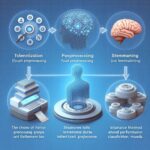GPT-3 Chatbot Benefits & Possibilities
Chatbots have become an essential part of modern business operations, providing an efficient and cost-effective way to handle customer inquiries and support. However, traditional chatbots have limitations in terms of their ability to understand natural language and respond appropriately. This is where GPT-3 chatbot technology comes in, offering a new level of sophistication and functionality that can revolutionize the way businesses interact with their customers. In this article, we will explore the benefits and possibilities of GPT-3 chatbots, as well as the challenges and limitations of implementing this technology in your business.
How GPT-3 Chatbots are Different from Traditional Chatbots
GPT-3 chatbots are powered by the latest artificial intelligence technology, enabling them to understand and respond to natural language input in a way that is more human-like than traditional chatbots. GPT-3 stands for “Generative Pre-trained Transformer 3”, which is a language model developed by OpenAI. Unlike traditional chatbots, which rely on pre-programmed responses, GPT-3 chatbots can generate responses on the fly based on the context of the conversation. This means that they can handle a wider range of inquiries and provide more personalized responses.
Benefits of Using GPT-3 Chatbots for Business
The benefits of using GPT-3 chatbots for business are numerous. Firstly, they can handle a wider range of inquiries, reducing the workload on human customer support staff. Secondly, they can provide more personalized responses, improving the customer experience and increasing customer satisfaction. Thirdly, they can operate 24/7, providing support outside of normal business hours. Fourthly, they can help to reduce costs by automating routine tasks and reducing the need for human staff. Finally, they can provide valuable insights into customer behavior and preferences, enabling businesses to improve their products and services.
GPT-3 Chatbots and Customer Service: A Perfect Match
GPT-3 chatbots are particularly well-suited to customer service applications, where they can handle a wide range of inquiries and provide personalized responses. They can help to reduce wait times and improve the overall customer experience. They can also provide valuable insights into customer behavior and preferences, enabling businesses to improve their products and services. However, it is important to ensure that the chatbot is designed to handle complex inquiries and can escalate to human support staff when necessary.
How GPT-3 Chatbots are Revolutionizing the Healthcare Industry
The healthcare industry is one area where GPT-3 chatbots are showing great potential. They can provide patients with personalized advice and support, reducing the workload on healthcare professionals. They can also help to improve patient outcomes by providing timely and accurate information. For example, a chatbot could help patients to manage their medication, provide advice on healthy lifestyle choices, or help them to navigate the healthcare system.
GPT-3 Chatbots and Education: A New Way of Learning
GPT-3 chatbots are also being used in education to provide personalized learning experiences for students. They can help to reinforce learning by providing immediate feedback and answering questions in a way that is tailored to the student’s level of understanding. They can also provide students with access to a wealth of information and resources, enabling them to learn at their own pace.
The Future of GPT-3 Chatbots: Possibilities and Limitations
The future of GPT-3 chatbots is bright, with new applications being developed all the time. However, there are also limitations to the technology, particularly in terms of data privacy and security. It is important to ensure that chatbots are designed with these issues in mind and that they comply with relevant regulations and standards.
GPT-3 Chatbots and Data Privacy: What You Need to Know
Data privacy is a major concern when it comes to chatbots, as they can collect and store sensitive information about customers. It is important to ensure that chatbots are designed with data privacy in mind, and that they comply with relevant regulations and standards. This may include implementing measures such as encryption, anonymization, and data access controls.
How to Build a GPT-3 Chatbot: A Step-by-Step Guide
Building a GPT-3 chatbot can be a complex process, but there are a number of tools and resources available to help. These may include chatbot development platforms, natural language processing APIs, and machine learning frameworks. It is important to have a clear understanding of the requirements and goals of the chatbot, as well as the technical skills and resources required to build and maintain it.
Examples of Successful GPT-3 Chatbots in Various Industries
There are already many successful examples of GPT-3 chatbots in various industries, including healthcare, education, finance, and e-commerce. For example, Babylon Health has developed a chatbot that provides medical advice and support to patients, while OpenAI has developed a chatbot that can generate creative writing prompts. These examples demonstrate the potential of GPT-3 chatbots to revolutionize the way we interact with technology.
Challenges of Implementing GPT-3 Chatbots in Your Business
Implementing GPT-3 chatbots in your business can be challenging, particularly in terms of technical skills and resources. It is important to have a clear understanding of the requirements and goals of the chatbot, as well as the technical skills and resources required to build and maintain it. It is also important to ensure that the chatbot is designed with data privacy and security in mind, and that it complies with relevant regulations and standards.
Is GPT-3 Chatbot Technology Right for Your Business?
GPT-3 chatbot technology offers a new level of sophistication and functionality that can revolutionize the way businesses interact with their customers. However, it is important to carefully consider the requirements and goals of your business before implementing a chatbot. You should also ensure that the chatbot is designed with data privacy and security in mind, and that it complies with relevant regulations and standards. With the right planning and implementation, GPT-3 chatbots can provide significant benefits to your business and improve the overall customer experience.













One thought on “Discovering GPT-3 Chatbots: Benefits & Possibilities”